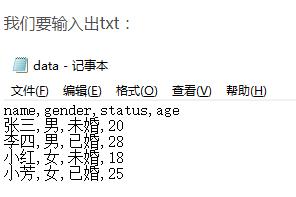python例子
Posted 浪子回头-小东清
tags:
篇首语:本文由小常识网(cha138.com)小编为大家整理,主要介绍了python例子相关的知识,希望对你有一定的参考价值。


list1 = [[\'张三\',\'男\',\'未婚\',20],[\'李四\',\'男\',\'已婚\',28],[\'小红\',\'女\',\'未婚\',18],[\'小芳\',\'女\',\'已婚\',25]] output = open(\'data.xls\',\'w\',encoding=\'gbk\') output.write(\'name\\tgender\\tstatus\\tage\\n\') for i in range(len(list1)): for j in range(len(list1[i])): output.write(str(list1[i][j])) #write函数不能写int类型的参数,所以使用str()转化 output.write(\'\\t\') #相当于Tab一下,换一个单元格 output.write(\'\\n\') #写完一行立马换行 output.close()


list1 = [[\'张三\',\'男\',\'未婚\',20],[\'李四\',\'男\',\'已婚\',28],[\'小红\',\'女\',\'未婚\',18],[\'小芳\',\'女\',\'已婚\',25]] output = open(\'data.txt\',\'w\',encoding=\'gbk\') output.write(\'name,gender,status,age\\n\') for row in list1: rowtxt = \'{},{},{},{}\'.format(row[0],row[1],row[2],row[3]) output.write(rowtxt) output.write(\'\\n\') output.close()
组合
combinations:不考虑顺序的排列组合 import itertools print list(itertools.combinations([1,2,3,4],3)) [(1, 2, 3), (1, 2, 4), (1, 3, 4), (2, 3, 4)] permutations:考虑顺序的排列组合 import itertools print list(itertools.permutations([1,2,3,4],2)) #第二个参数2表示要选几个对象 [(1, 2), (1, 3), (1, 4), (2, 1), (2, 3), (2, 4), (3, 1), (3, 2), (3, 4), (4, 1), (4, 2), (4, 3)]
from itertools import product l = [1, 2, 3] print (list(product(l, l))) print (list(product(l, repeat=3))) 结果: [(1, 1), (1, 2), (1, 3), (2, 1), (2, 2), (2, 3), (3, 1), (3, 2), (3, 3)] [(1, 1, 1), (1, 1, 2), (1, 1, 3), (1, 2, 1), (1, 2, 2), (1, 2, 3), (1, 3, 1), (1, 3, 2), (1, 3, 3), (2, 1, 1), (2, 1, 2), (2, 1, 3), (2, 2, 1), (2, 2, 2), (2, 2, 3), (2, 3, 1), (2, 3, 2), (2, 3, 3), (3, 1, 1), (3, 1, 2),
(3, 1, 3), (3, 2, 1), (3, 2, 2), (3, 2, 3), (3, 3, 1), (3, 3, 2), (3, 3, 3)]
from functools import reduce fn = lambda x, code=\',\': reduce(lambda x, y: [str(i)+code+str(j) for i in x for j in y], x) # 直接调用fn(lists, code) list1 = [1, 2] list2 = [3, 4] list3 = [5, 6] res = fn([list1, list2, list3]) print(res) [\'1,3,5\', \'1,3,6\', \'1,4,5\', \'1,4,6\', \'2,3,5\', \'2,3,6\', \'2,4,5\', \'2,4,6\']
一、笛卡尔积:itertools.product(*iterables[, repeat]) 直接对自身进行笛卡尔积: import itertools for i in itertools.product(\'ABCD\', repeat = 2): print (\'\'.join(i),end=\' \') 输出结果: AA AB AC AD BA BB BC BD CA CB CC CD DA DB DC DD print (”.join(i))这个语句可以让结果直接排列到一起 end=’ ‘可以让默认的输出后换行变为一个空格 两个元组进行笛卡尔积: import itertools a = (1, 2, 3) b = (\'A\', \'B\', \'C\') c = itertools.product(a,b) for i in c: print(i,end=\' \') 输出结果: (1, ‘A’) (1, ‘B’) (1, ‘C’) (2, ‘A’) (2, ‘B’) (2, ‘C’) (3, ‘A’) (3, ‘B’) (3, ‘C’) 二、排列:itertools.permutations(iterable[, r]) import itertools for i in itertools.permutations(\'ABCD\', 2): print (\'\'.join(i),end=\' \') 输出结果: AB AC AD BA BC BD CA CB CD DA DB DC 三、组合:itertools.combinations(iterable, r) import itertools for i in itertools.combinations(\'ABCD\', 3): print (\'\'.join(i)) 输出结果: ABC ABD ACD BCD 四、组合(包含自身重复):itertools.combinations_with_replacement(iterable, r) import itertools for i in itertools.combinations_with_replacement(\'ABCD\', 3): print (\'\'.join(i),end=\' \') 输出结果: AAA AAB AAC AAD ABB ABC ABD ACC ACD ADD BBB BBC BBD BCC BCD BDD CCC CCD CDD DDD
以上是关于python例子的主要内容,如果未能解决你的问题,请参考以下文章
